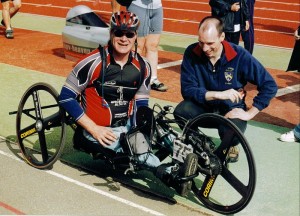Accidents that lead to paralysis can be devastating. Even though mobility becomes limited in such accidents, the active spirit of the individual does not. Thankfully, technology allows for individuals to continue to be active even after these accidents. Such is the case with cycling. Handcycles offer the best opportunity for those with disabilities who want to continue being active cyclists. Ever since they were developed in the 1980s, handcycles have opened up a new world to competitive and recreational cyclists. Handcycles offer a wonderful, alternative way to strengthening cardiovascular health and upper body strength.
Handcycling
Handcycles, as the name suggests, are like bicycles but are hand-powered. Usually tricycles in form, these handbikes have two rear wheels and a front steerable wheel. Hand cranks on either side help steer and propel the bike forward. They are designed allow the rider to use their whole body to steer and power the bike. Depending on the intended use, handbikes come in different shapes and sizes. They are available for touring, racing, off-roading, or as simple, everyday recreational rides.
Upright handcycles are generally recommended for beginning riders, and are not built to go higher than about 15 mph. Recumbent handcycles are more varied. They have two available steering options: fork-steer (more popular system) and lean-to-steer. They also have different seating options which allow the rider to either lean back or lean forward. Brand new handcycles, on average, range in cost from $1,500-$4,000.
The U.S. Handcycle Federation is the governing body for handcycle racing in the United States. The International Cycling Union (or Union Cyclist Internationale) is the world governing body for international competitive cycling. In 2009, the International Cycling Union established a unified classification system for handcycles to make competitive cycling easier to judge and to specify the bikes that are built to accommodate various levels of restricted mobility. These four classes (H1–H4) help riders identify the kinds of bicycles they can use. Classes H3 and H4 are specifically for paraplegics and amputees; the difference between the two is determined by whether the rider can kneel on the handcycle or not. H3 can use AP2, AP3, and ATP2 handcycles while the H4 classification can use an ATP3 handcycle.
Handcycling and Para-cycling Opportunities in Utah
The following table provided by the USA paralympics website provides contact information for sources for those who are interested in pursuing opportunities to compete or to join others in group recreational riding here in Utah.
| Organization | State | Contact |
|---|---|---|
| Salt Lake County Adaptive Recreation – Paralympic Sport Salt Lake County 8446 S. Harrison St. Midvale, UT 84047 |
UT | Jeff Burley 801-559-1500 jburley@slco.org |
| National Ability Center – Paralympic Sport Park City 1000 Ability Way Park City, UT 84060 |
UT | Ellen Adams 435-200-0995 ellena@discovernac.org |
| University of Utah Health Care Rehabilitation Center – TRAILS – Paralympic Sport Club Salt Lake City 50 North Medical Drive Salt Lake City, UT 84132 |
UT | Tanja Kari 801-581-2526 tanja.kari@hsc.utah.edu |
| Utah Wheelin’ Jazz 7255 S. Swan Hill Dr. West Jordan, UT 84084 |
UT | Jeff Griffin 801-842-1213 Griffinja@ldschurch.org |
| Team River Runner Salt Lake City Salt Lake City Salt Lake City, UT 84104 |
UT | Tim Troy 801-391-4759 brineshrimpdirect@gmail.com |
| Common Ground Outdoor Adventures 335 North 100 East Logan, UT 84321 |
UT | Sammie Macfarlane (435) 713-0288 cg@cgadventures.org |
USA Cycling Amateur and Para-cycling Road National Championships
The USA Cycling Amateur and Para-cycling Road National Championships are held every year. This year they will be held July 3-7 in Madison, Wisconsin.
Source: Adaptive Handcycling

